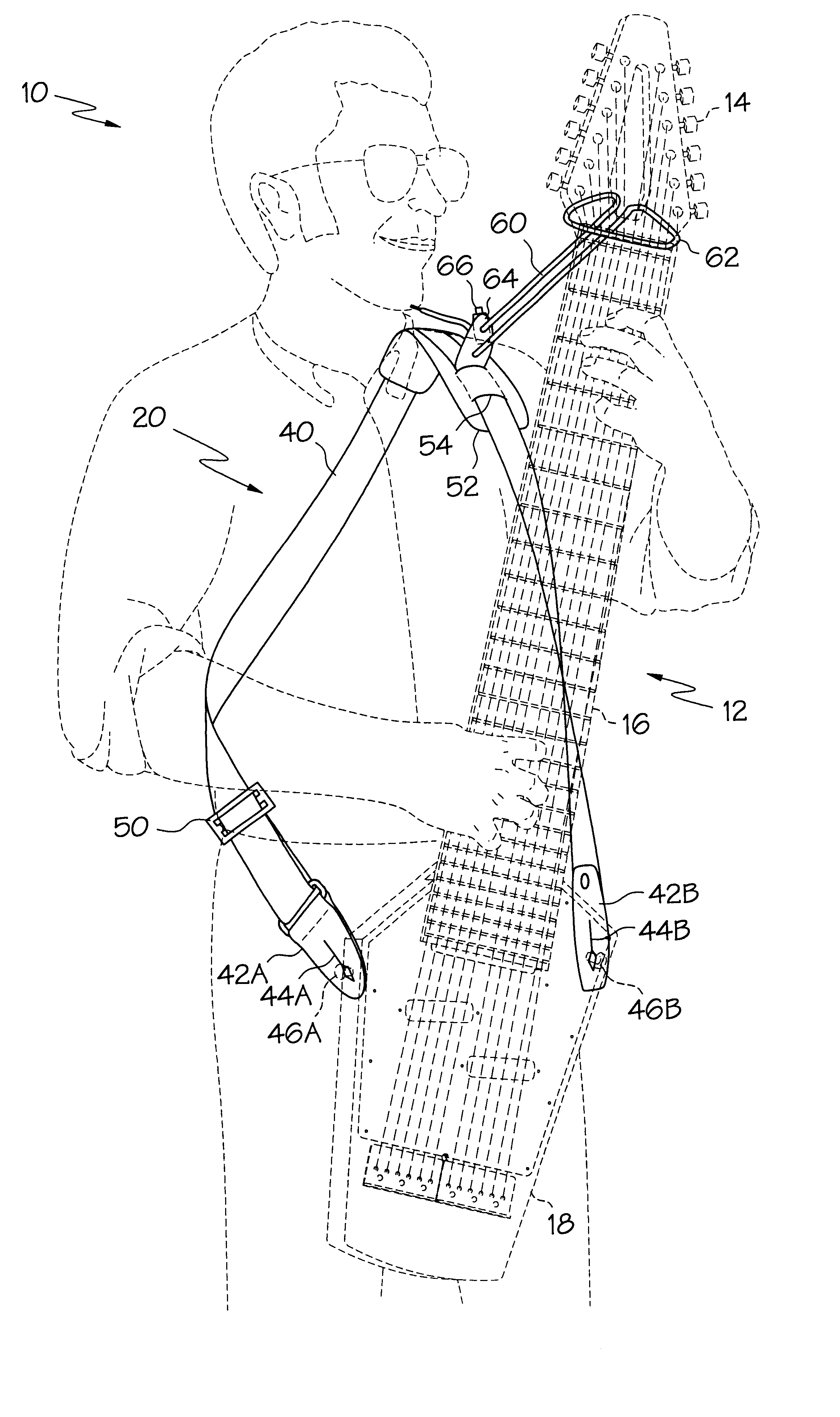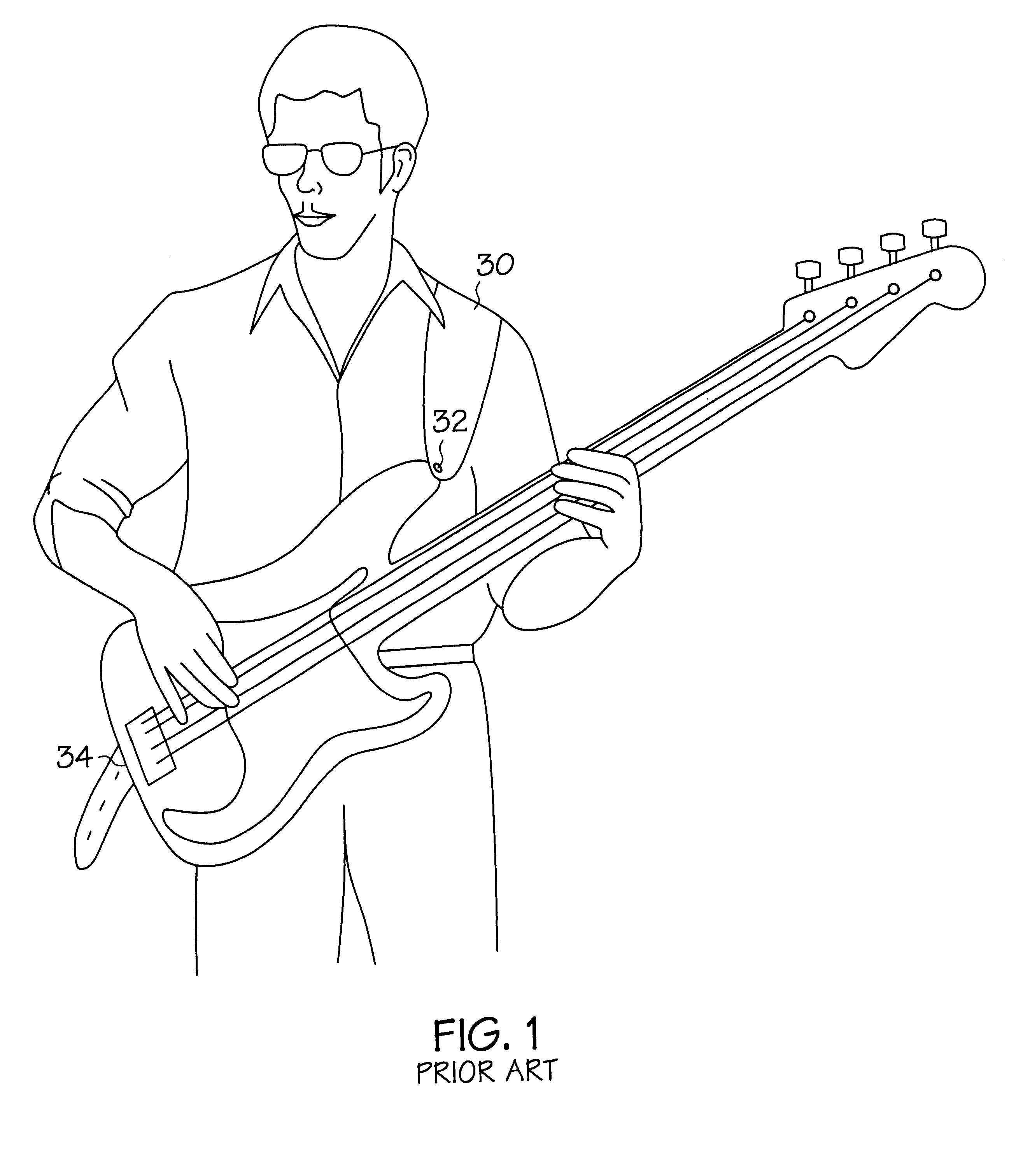Although the near-vertical positioning of an instrument affords these benefits, it is difficult for a musician to maintain a stable near-vertical position with most existing support systems such as straps, belts, and belt-hooks.
In addition, many modern electric guitars and especially electric basses are quite heavy, so that supporting an instrument during extended periods of play is fatiguing to a musician, which in turn impairs the musician's ability to play well.
However, many existing support systems function poorly in one or the other of the two playing positions.
However, in this crowded field, the solutions previously developed fail to address all the issues, or in some cases create other performance difficulties such as requiring substantial time to don or remove, or such as interfering with the performer's costume.
However, for
alternative methods of play that are facilitated by positioning the instrument in a near-vertical position, the common guitar strap does not fare so well.
The common guitar strap will not hold an instrument in a stable near-vertical position, because as soon as the left hand is removed from the neck, the weight of the tuner head causes it to sink to a lower level where it finds equilibrium.
This problem is exacerbated when playing high-pitched notes near the instrument's body, because the left hand can offer minimal support, or when playing touch-style or two-handed tapping, again because the hands can offer minimal support.
Although the shoulder-pad often affords adequate
weight distribution, it may not be enough distribution to make the heaviest instruments comfortable.
Also, shoulder-pads are frequently known to slide forward or backward off the musician's shoulder during a performance, and once so ill-positioned, they afford no benefit.
This triangulated attachment stabilizes the instrument, preventing side-to-side movement, but if the tuning head is raised high it will not remain there, and the full weight of the instrument is still borne on one of the musician's shoulders, which is uncomfortable for any length of time.
Further, although the strap offers some weight redistribution to the musician's
torso, most of the instrument's weight still rests on one of the musician's shoulders, which can be uncomfortable.
Further, this device may require substantial time to don or remove, and if the musician is female, it may be uncomfortable to the breasts.
However, if the tuning head is positioned in near-vertical position, the dual tensions of the strap
assembly will quickly lower the head again.
Although this is appropriate for an instrument which balances nicely such as a saxophone, it does not work for an
electric guitar or especially electric bass, both because the tuner head has top-
heavy weight which tends to fall to one side or the other, and because on the body of the instrument it is difficult to find a single
balance point which does not permit the instrument to flop around unpredictably.
Although this arrangement could be modified to provide near-vertical positioning, there would then be nothing to prevent the top-heavy tuning head from falling to the musician's right, carrying the support strap off the musician's shoulder.
Further, although this arrangement provides some weight redistribution to the musician's hips, the device is more expensive to manufacture, may interfere with the performer's costume, is time-consuming to don or remove, and will not permit seated play.
However the orientation of the instrument is not stabilized, which permits the tuner head of the instrument to fall forward, away from the musician's body, or to move back toward the musician's head, and even in some cases to strike the musician on the head if the musician is less than alert.
This easily provides near-vertical positioning, although a heavy instrument could weigh uncomfortably on the musician's belt, or in the case of unbelted trousers with an elastic waistband, the instrument could unpredictably disrobe the musician.
If the musician's hands are removed from the instrument, it will fall.
Further, because the base of the instrument is pressed by the hook very close to the musician's lower
torso, the instrument interferes with the seat of a chair if the musician attempts to sit down to play.
This is a stable
support system that provides near-vertical positioning, but again the weight borne on the musician's trousers belt can be uncomfortable or can pull the trousers down.
Further, this upper strap can interfere with the performer's costume, and also may not be comfortable to female musicians.
Finally, the belt-hook
assembly positions the base of the instrument in such a way that it can interfere with most types of seating if the musician is attempting to play while seated.
Although the instrument can be quickly donned or removed, the
assembly does not permit near-vertical positioning, the belt assembly can weigh uncomfortably on the musician's body, and the device will not support an instrument during seated play.
As long as the player also uses his or her hands upon the upper fretboard of the instrument it will remain positioned in an upright and stable orientation, but of course the apparatus is of no assistance during standing play.
However, none of these provide near-vertical positioning, nor stability when the bands are removed from the instrument, nor support during standing performance.
 Login to View More
Login to View More  Login to View More
Login to View More 


